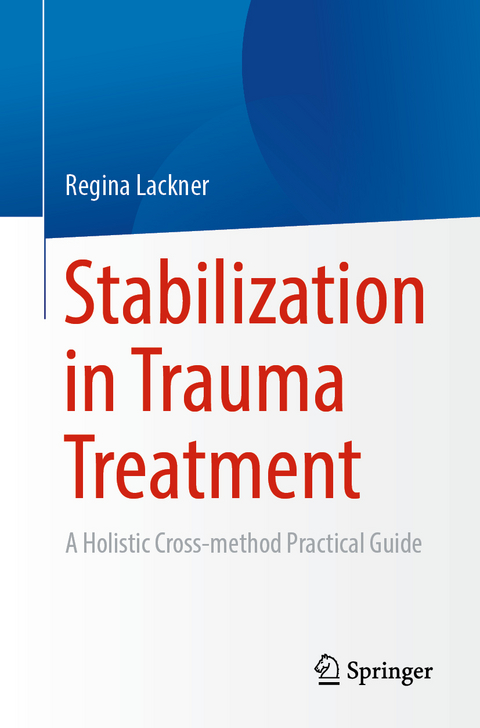
Stabilization in Trauma Treatment
Springer Berlin (Verlag)
978-3-662-67479-6 (ISBN)
Stabilization is considered the first of the three stages of trauma treatment and a prerequisite for successful trauma confrontation. But what does stabilization mean, what effect does it have and, above all, what variety of stabilizing interventions are available?
This practical guide presents various approaches and a wealth of different interventions and exercises that have proven themselves in practice. In addition, it clearly shows that stabilization can achieve much more than one might expect: it brings with it a variety of other effects, so that it contributes to a comprehensive strengthening and healing of our clients. Thus, it facilitates, accelerates and expands the process of trauma treatment. A large repertoire of interventions, exercises and suggestions, as well as numerous examples, illustrate its implementation in practice. The book is intended for psychotherapists, psychologists, physicians, and members of other helping professions.
Content:
- Necessity, importance and effect of stabilization
- Basics relevant to practice
- Safety and resources
- Various interventions and exercises
- Suggestions and examples from practice
lt;b>Dr. Regina Lackner is a clinical and health psychologist and psychotherapist in private practice with a focus on trauma therapy.
1. Stabilization - necessity, effect benefits.- Part A Practice-relevant basics.- 2 Traumatization in its diversity.- 3 Neuroscientific insights.- 4 Our body and its importance for stabilization.- 5 Embodiment - the interaction between body and psyche.- 6 Resilience.- 7 Posttraumatic growth.- 8 Resources - the heart of stabilization.- 9 Mindfulness and self-awareness.- 10 Imagination - the power of inner images.- 11 Inner parts.- 12 The power of positive thoughts.- 13 Movement - physical and sport activity.- 14 Spirituality and religion.- 15 Loss and grief - saying goodbye and transforming the relationship.- 16 Anger - the power of positive thoughts. 11 Inner parts.- 12 The power of positive thoughts.- 13 Exercise - physical and sporting activity.- 14 Spirituality and religion.- 15 Loss and grief - saying goodbye and transforming the relationship.- 16 Anger and aggression.- 17 Our inner attitude.- 18 Digression: looking at the positive and strengthening.- 19 Giving security and support.- 20 The importance of psychoeducation.- Part D Exercises and intervention.- 21 Explaining stabilization - selecting, explaining and applying exercises and interventions.- 22 Exploring, activating, strengthening and expanding resources.- 23 Feeling safe and protected.- 24 Gaining inner strength.- 25 Calming the nervous system - coming to rest and relaxing.- 26 Reducing restlessness and inner tension.- 27 Finding your way out of dissociations.- 28 (Re)feeling the body.- 29 Stopping flash-backs and getting out of them.- 30 Stopping thoughts and leaving them behind. 30 Stopping thoughts and leaving them behind.- 31 Reducing and managing anxiety.- 32 Intercepting and resolving panic attacks.- 33 Loosening and releasing numbness.- 34 Relieving dejection, powerlessness, and hopelessness.- 35 Dealing with anger and resentment.- 36 Exploring and perceiving boundaries.- 37 Discarding guilt.- 38 Overcoming shame.- 39 Understanding and replacing self-injurious behavior.- 40 Understanding and changing suicidal thoughts.- 41 Doing something else good for yourself.
| Erscheinungsdatum | 30.07.2024 |
|---|---|
| Zusatzinfo | XIX, 304 p. 10 illus. |
| Verlagsort | Berlin |
| Sprache | englisch |
| Maße | 155 x 235 mm |
| Themenwelt | Geisteswissenschaften ► Psychologie ► Traumatherapie |
| Medizin / Pharmazie ► Medizinische Fachgebiete ► Psychiatrie / Psychotherapie | |
| Schlagworte | different therapy approaches • Holistic Approach • Imagination • PTSD • Trauma Confrontation • Trauma Therapy • Variety of methods |
| ISBN-10 | 3-662-67479-3 / 3662674793 |
| ISBN-13 | 978-3-662-67479-6 / 9783662674796 |
| Zustand | Neuware |
| Haben Sie eine Frage zum Produkt? |
aus dem Bereich


